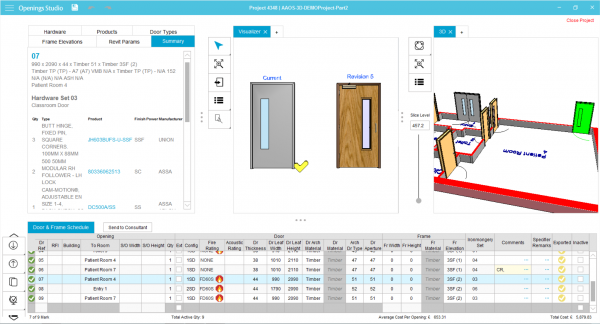
GUEST ARTICLE: The changing face of BIM
 BIM (Building Information Modelling) has been prevalent for a number of years now, but how is it being used in practice? And what advancements are being made to ensure it is making tangible benefits to all stakeholders in the supply chain? Here Eric Spooner, BIM Manager for ASSA ABLOY Opening Solutions Project Specification Group, explores.
BIM (Building Information Modelling) has been prevalent for a number of years now, but how is it being used in practice? And what advancements are being made to ensure it is making tangible benefits to all stakeholders in the supply chain? Here Eric Spooner, BIM Manager for ASSA ABLOY Opening Solutions Project Specification Group, explores.
According to the National BIM Survey 2019, BIM adoption has grown from little more than 10% in 2011 to around 70% in 2019. However, we must be careful that BIM is not undertaken as a ‘tick box’ exercise, but rather seen as an important tool for collaboration, delivering tangible benefits for all stakeholders.
In many ways, BIM is old news, and as is often the case with any building practice that has been legislated for, it becomes less about the benefits of meeting it and more about the missed opportunities of not implementing it properly.
Collaboration and the sharing of data is vital to the success of BIM. At its heart, BIM is a tool that reduces waste and risk of error, and facilitates the sharing of detailed information throughout the design, construction and operational phases of a project, which ultimately results in more efficient buildings.
When it comes to doorsets and ironmongery in particular, using BIM-enabled tools such as ASSA ABLOY’s Openings Studio™ can truly unlock the potential of BIM.
At the specification stage, tools such as these can drive efficiencies in creating door schedules because they are integrated and can be linked to fire certifications and energy performance documents. Having one easily accessible source allows architects and specifiers to update relevant information automatically without having to manually input each specification, saving time and money.

Contractors can then view all this information to assess precise quantities, pricing, compliance, links to supplier websites and installation instructions. In addition, contractors are also able to track the status of installations across the project much more effectively.
And finally, these tools ensure post-construction processes – such as environmental accreditations and handovers to facilities managers – are managed effectively. Not only this, but the ongoing performance and maintenance of the building may also be monitored via QR codes and a weblink to where all documents and certificates are located. This means that when a site gets audited, all information is easily accessible.
Clearly, BIM-enabled tools are essential in keeping projects on track, reducing the as-built performance gap, initiated by the collaboration of architects and specifiers and monitored by facilities managers. Indeed, tools that can be utilised across the whole supply chain add considerable value to any project, as well as encouraging investment, innovation and growth throughout the industry.
So it is clear that when the BIM process and related technologies are implemented correctly, they bring many benefits to a project. Use of tools such as Openings Studio enables collaboration, breaking down silos and forming a new approach to information development and distribution. This is an exciting time, and we must now take advantage of it to help create a step-change in productivity, transparency and quality within the building industry.
For more information on ASSA ABLOY Project Specification Group’s BIM-enabled Openings Studio software for the entire building lifecycle, please call 0845 071 0882, email [email protected] or visit the website.
Latest news

1st May 2024
Easy transportation with Makita’s DCU601 36V LXT
Power tool manufacturer Makita has added a new battery powered wheelbarrow to its extensive LXT outdoor power equipment range.
Posted in Articles, Building Industry News, Building Products & Structures, Garden, Hand Tools, Innovations & New Products, Plant, Equipment and Hire, Power Tools, Restoration & Refurbishment, Retrofit & Renovation, Site Preparation
1st May 2024
Hydro International incorporates future-proof design for Hydro-Brake® Optimum
Hydro International, an industry leader in water management products and services, is redefining the standard for hydraulic efficiency and adjustability.
Posted in Articles, Building Industry News, Building Products & Structures, Building Regulations & Accreditations, Building Services, Drainage, Drainage Services, Drainage, Guttering, Soffits & Fascias, Facility Management & Building Services, Information Technology, Innovations & New Products, Plumbing, Retrofit & Renovation, Sustainability & Energy Efficiency
30th April 2024
ASSA ABLOY Door Group strengthens offering with partnership
ASSA ABLOY Door Group is proud to announce a new internal restructure that sees the company joining forces with all comparable business units across Europe, the Middle East, India and Africa, to form a new global division – the ASSA ABLOY EMEIA Door Business Segment.
Posted in Access Control & Door Entry Systems, Architectural Ironmongery, Articles, Building Associations & Institutes, Building Industry News, Building Products & Structures, Building Services, Doors, Facility Management & Building Services, Restoration & Refurbishment, Retrofit & Renovation, Security and Fire Protection
30th April 2024
Geberit exhibiting at British Pig & Poultry Fair 2024
Bathroom and piping manufacturer Geberit will be exhibiting at the British Pig & Poultry Fair at NEC Birmingham (15 – 16 May 2024).
Posted in Articles, Building Industry Events, Building Industry News, Building Products & Structures, Building Services, Exhibitions and Conferences, Facility Management & Building Services, Innovations & New Products, Pipes, Pipes & Fittings, Plumbing, Retrofit & Renovation
 Sign up:
Sign up: